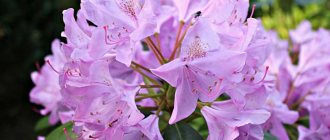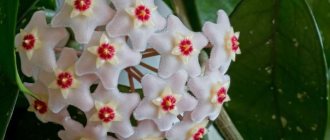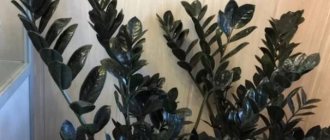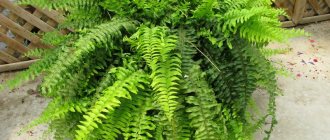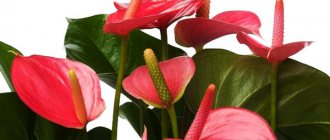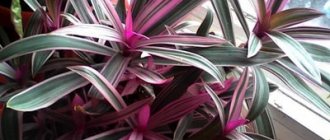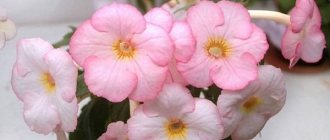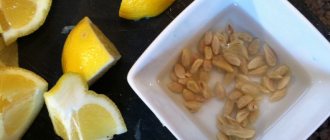The exotic elegance and noble appearance of palm trees attract many gardeners and flower lovers, but they are quite expensive and demanding to care for, so indoor plants that visually resemble palm trees are becoming increasingly popular. They are an excellent decoration for various interiors and fill the interior space with a special tropical charm.
Being representatives of different families, these flowers require different maintenance conditions. To choose the most suitable copy for a particular room, you need to clearly understand its features and needs.
What house plants are similar to palm trees?
Among the commonly found indoor plantings that have an external resemblance to a palm tree are: bocarneya, dracaena, dieffenbachia, and spurge. To decide on the choice of exotic foliage decoration for your home, you need to become more familiar with their main characteristics.
Beaucarney
An interesting indoor plant of Mexican origin has won the recognition of lovers of home floriculture due to its resistance to temperature changes, undemandingness to watering, and the ability to tolerate minor drought quite painlessly. It can be safely placed near heating appliances. The only thing is that bokarneya does not bloom indoors.
This plant is also called the “bottle tree”. It has thin ribbon-shaped leaves that are located on a thick trunk. It is better to keep it at a temperature of 10-26 °C on the windowsill of a window facing southwest or south. In summer, the flower is irrigated once every 7 days, and in winter once every 2-3 weeks. Feeding procedures are carried out from April to October - every 14 days.
Dieffenbachia
The Latin American plant is distinguished by its intensive growth rate; in just 5 years it can reach a height of 2 m. This evergreen plant has large leaf blades that are oval in shape and variegated in color. The culture does not produce flowers when grown in closed spaces. It is valued for its massive green stem and evenly growing large leaves.
The plant does not tolerate drafts and temperature fluctuations. It needs sufficient light, but it should not be exposed directly to the leaves, otherwise there is a high risk of burns. Irrigation activities should be carried out only with settled boiled water. Due to the poisonous nature of the sap, pruning the flower should be done with protective gloves.
Dracaena
The tropical guest, whose homeland is Africa, is a lush shrub with straight, sharp leaves. Its advantage is its compact size - up to 40 cm. By trimming the top part of the plant, you can add splendor. After pruning, two branches appear from one branch. From the cut top, after rooting in water, it is possible to obtain another flower.
The advantage of dracaena is its unpretentiousness to growing conditions. It is enough to provide the room with proper lighting, regularly irrigate it (once every 2 days in the summer and once every three days in the winter), loosen the soil and promptly change the container to a larger one.
Euphorbia white-veined
The name of the plant itself already fully describes it. On a dark green background, clearly visible white veins are the main feature of the flower. He is originally from Madagascar. The trunk of the milkweed is massive and ribbed. Wide oval-shaped leaves are formed on long petioles; they are located on the upper part of the stem. Already on an adult plant, miniature brown thorns appear in place of the plates. The height of this species is 1.5 m.
Decorative crops belong to the category of evergreens. Its homeland is South America. Yucca belongs to the agave family and does well in regions with temperate climates. It has a high degree of frost resistance. The inflorescences are white in color and are formed in the form of elegant large bells.
The height of the woody stem is almost 2 m. The leaf blades are long, large, and have a sword-shaped shape. In greenhouse complexes, mainly specimens with thick, erect stems are planted. The green mass grows in a bunch at the top.
Yucca is undemanding in terms of keeping conditions; it is best to place it on the windowsill of a window with a western or eastern orientation; in winter, it needs to be provided with additional lighting using phytolamps. Watering should be plentiful; in the cold season, irrigation is done in moderate dosage. Liquid nutritional formulations are applied from April to October, with a frequency of application once every 7 days.
Liviston
Distinctive features of the Cymbidium orchid.
What types of flowers are suitable for home growing? A palm tree whose leaves resemble a fan, the main advantage of the plant is its rapid growth and minimal care. Livistona has a large number of varieties, but the most common are: southern, round-leaved, Chinese, beautiful, deceptive, and in total there are more than 30 species. This plant loves a humid climate, so the palm tree should be frequently sprayed and watered, preventing the top layer of soil from drying out.
The temperature at which the plant will feel comfortable is +13 o +16 o C in the summer; in winter, the temperature should not drop to +8 o C. It must be fed frequently, since with active growth, Liviston should receive enough nutrients.
Dieffenbachia
Another alternative to palm. An exotic plant that will constantly delight you with its evergreen color. By origin, Dieffenbachia has Latin American roots, is characterized by particularly rapid growth, and within 4-5 years it can grow up to two meters in height.
Basic rules for caring for Dieffenbachia:
Since Dieffenbachia grows quickly, care must be taken to ensure that the plant is not crowded. And this applies not only to the place where Dieffenbachia will grow, but also to the container. It is better to purchase a large pot for this indoor plant or even plant it in a bucket.
How is care carried out?
Temperature
Hoya or wax ivy: all the nuances of growing and caring for at home
Climatic conditions for the normal care of areca chrysalidocarpus are also an important condition. Normal temperature values for this plant are 35 °C above zero. But achieving such conditions at home is not always possible.
Therefore, it is necessary to maintain the temperature at least at 24 degrees. If the growing conditions are unsuitable, the temperature is too low for a long time, the areca chrysalidocarpus or another type of palm begins to gradually die.
Another important condition is high humidity in the room. The ideal habitat for such plants is the tropics with high humidity and temperature. Therefore, if areca is grown, care at home involves creating conditions as close as possible to natural ones. The first sign of lack of moisture is depletion and dullness of the foliage mass, curling and yellowing of the leaves.
Watering
Watering is carried out when there is slight drying of the plant’s root system. The areca flower is very finicky; if watered with hard water, it can even die, so it is recommended to specially settle the water or collect rain and melt water. The main factor in the death of a plant when grown in an apartment is excessive watering.
It is necessary to place a tray under the pot with the plant; when liquid collects in it, it must be removed as soon as possible, immediately after watering. If the root system begins to rot, the flower will die.
The first sign that the root system is beginning to rot is a change in the color of the foliage. The leaves and stems of the flower begin to turn dark. In order for watering to take place fully, it is necessary to comply with the conditions for proper planting - the pot must have drainage holes.
The name of a home flower similar to a palm tree
Subtleties and nuances of planting lilies and caring for them: a complete overview of growing technology
The exotic elegance and noble appearance of palm trees attract many gardeners and flower lovers, but they are quite expensive and demanding to care for, so indoor plants that visually resemble palm trees are becoming increasingly popular. They are an excellent decoration for various interiors and fill the interior space with a special tropical charm.
Being representatives of different families, these flowers require different maintenance conditions. To choose the most suitable copy for a particular room, you need to clearly understand its features and needs.
Other types of houseplants most similar to palm trees
True representatives of the Palm family require special conditions for growth and development. They need a lot of light, but direct exposure to the sun is contraindicated. Moist air and sufficient free space are vital.
In the realities of an apartment, creating conditions that meet such requirements is quite difficult. An excellent solution is to purchase palm-like plants. Such specimens look very impressive, but require much less effort to maintain.
Indoor plants from the Palm family
Several types of palm trees are suitable for home cultivation. It is worth familiarizing yourself with the most common and unpretentious plants in order to make the right choice.
Areca
Has many varieties. In nature, Areca can grow up to 20 meters. In apartment conditions, plants are grown that grow from the soil in the form of a bush. Feathery, bright green foliage covers the top of the slender stems.
The most popular indoor representative is Chrysalidocarpus, which is found in the wild in Madagascar, tropical Asia and Oceania. Several stems of equal thickness rise from the pot, forming a dense bush with the help of dense foliage. In indoor conditions, it almost never blooms.
Areca
Caring for domestic Areca is quite simple. To do this, you should adhere to the following rules:
provide bright lighting, periodically ventilate the room in hot weather, and use additional light sources in winter; in the warm season, maintain the temperature at +22-25 degrees Celsius, and in winter do not allow it to drop below +16°C; Areca requires high humidity, so it needs to be constantly sprayed, and in winter the leaves must be wiped with a damp cloth; For irrigation, warm, settled water should be used. In summer, Areca is watered abundantly, so that the soil dries out no more than 2-3 cm
In winter, watering should be reduced; It is important to feed the soil from April to October twice a month, and in winter to apply fertilizer monthly.
Liviston
This palm belongs to the fan varieties, which are characterized by dissection of the leaves at three-quarters of the length. At home, it grows up to two meters. The leaves of such specimens are on cuttings up to 60 cm long, which grow from the base of the stem. An adult plant has a spectacular appearance.
When caring for this home plant, it is recommended to adhere to the following rules:
- maintain the indoor temperature from 14 to 22 degrees Celsius throughout the year;
- water only with soft, settled, warm water as the soil dries;
- periodically you need to spray the leaves and remove dust from their surface with a damp cloth, give young specimens a warm shower;
- Fertilize the soil three times a month in spring and summer, and monthly in autumn and winter.
Liviston
Trachycarpus
It is considered the most resistant to low temperatures among members of the palm family. Adult specimens with a formed trunk can withstand frosts down to -15 degrees Celsius. A fan-shaped leafy crown is located on the upper part of the fibrous trunk. The leaves are green in color and have a bluish tint along the edges. Often found in Crimea.
Trachycarpus
Caring for Trachycarpus at home follows certain rules that take into account its characteristics:
- maintain the optimal temperature for this palm tree – 18-25 degrees Celsius;
- the room in which the plant is located must be ventilated periodically;
- protect leaves from direct sunlight by providing bright, diffused lighting;
- use light soil with good drainage, do not flood the plant, as this often causes rotting of the root system;
- once a month you should arrange a warm shower for the leaves; to humidify the air, you can place a container of water next to the plant;
- in the spring and summer, fertilizers need to be applied monthly.
Decorative indoor types
Indoor views are not only exotic and greetings from the tropical forest, they also serve as an important detail in the interior, often changing it almost radically. It is worth keeping in mind that not all palm trees are suitable for growing indoors. Most often, the following types of indoor palm trees are chosen for these purposes (with photos and names):
- Dates. Date palms are the most common. Currently, there are more than 17 species; in the wild they grow in Africa and Asia. If you plant an ordinary date seed in a pot, it will germinate after a while. These seeds have almost 100% germination rate, but they germinate for about a month. Literally in 5 years the young tree will become decorative. It is best to purchase palmate dates for this purpose. This species does not grow in the wild. Indoors it can grow up to 6 m in height. However, this will take several decades. Date palms also include the Robelena date. The fruits of this plant are inedible. Palm trees have a crown with leaves that curve gracefully downwards. The trunk of the plant is also original, as if shaggy.
- Areca Chrysalidocarpus. It grows naturally in Indian forests. The crown is a huge bunch of leaves at the top of the trunks, which reach one meter in length. The trunk is covered with a large number of scars arranged in the shape of a ring. The fan of Trachycarpus will look very original indoors. This plant is ideally suited to growing indoors. The culture blooms and bears fruit. But Kariota grows fastest in indoor conditions. This plant is noticeably different from other species. Outwardly it resembles a triangle that stretches upward. Life expectancy is no more than 20 years.
- Washingtonia. This decorative palm has a crown in the form of a large bright green fan. Growing this species does not require specific knowledge; the plant is unpretentious in care.
- Coconut (rubber). This plant will be the most difficult to grow indoors. It will require a lot of light to grow. The coconut tree is best suited for placement in a winter garden. There are mainly two types grown indoors: Weddel coconut and nuciferous coconut.
- Hamedorea (bamboo, water or cat palm). These species are ideal for growing indoors. Hamedorea unicolor, graceful, oblong and tall are especially ideal for these purposes.
- Liviston. These plants have been grown indoors for several centuries. They are very decorative and small, but for successful cultivation they will require special conditions.
- Rapis. Unpretentious and slow-growing bushy palms with soft, dark green leaves. They are ideal for indoor growing. They easily tolerate all the inconveniences: dry air, poor lighting and drafts. Outwardly they are very similar to Rapis Kentia, which can also be easily grown indoors.
- Hameropsy. These indoor plants are widespread, very decorative and unpretentious, and grow slowly. Over time, the trunk becomes overgrown with brown fibers, the leaves are feathery and thorny.
Butia is one of the most capricious, but if you find an approach to it, the plant will delight you with a surprisingly graceful crown with feathery leaves.
Rare species include Gioforba. Externally, the plant is a small palm tree, with peculiar leaves and a trunk that resembles a bottle at the bottom. Another rarity is Sabal, whose homeland is the subtropics of America. The plant is low, the leaves are bluish-green, growing on short petioles.
And only passionate lovers of palm trees know about the Betel variety, which is distinguished by beautiful large trunks and a lush crown. In its natural habitat, the palm grows up to 20 m in height and also has two-meter leaves. In indoor conditions it can grow for a long time, but at the same time it has a more modest size.
Hovea
A beautiful palm with a tropical appearance that will charm any gardener, it is quite tall, the leaves are feathery and the trunk is covered with leaf scars, it grows slowly. Howea comes in two varieties: Foster and Belmora.
Like any type of palm tree, Howea indoor plants love moist air and do not like drafts, so this plant should be sprayed and watered after the soil has dried. The temperature for best stay in room conditions should be +19 o +23 o In summer, the temperature in winter should not drop to +16 o C. Direct rays of the sun should not fall on the plant, as it can cause burns on the leaves.
What are false palms?
False palms (false palms) are plants of other families that look similar to palms. In other words, these are the same trees with bare columnar trunks and leaves growing from the crown.
Among the most famous false palms are Yucca, Dracaena, Cycad, Nolina, Pandanus, Cordilina.
Among amateur gardeners there is no division between real and false palms, since plants are usually named by their appearance. Therefore, Yucca, Nolina, and other plants are grown as palm trees.
INTERESTING. Some plants (for example, Hibiscus, Palmetta) can be pruned so that they also look like a palm tree.
Date palm
The houseplant belongs to the palm family, reaches a height of 1 to 2 meters, the leaves are narrow and oblong in shape, the trunk is shaggy. It is unpretentious in care, but you should adhere to the following rules for caring for an exotic plant: watering, lighting, fertilizing, temperature conditions.
Watering in the summer should be plentiful, several times a week, and the soil should not be allowed to dry out, since when the soil dries out, spots will appear on the leaves that will not be able to recover even when the water balance is restored. In winter, watering should be moderate; leaves should be watered and sprayed with settled water.
The sun's rays have a beneficial effect on the date palm; in poor lighting, the leaves of the plant will hang down; in summer it is advisable to take it out into the fresh air.
The temperature in the room is excellent for a tropical plant, but the temperature should not exceed +25 o C, and drop to +10 o C. With abundant growth, it is necessary to fertilize 2 times a month, with special fertilizers for palm trees, which are sold in specialized stores.
Areca
In nature, this amazing palm tree can be found in India.
An evergreen tree with large variegated leaves at the top attracts attention. At home, Areca can grow up to 2 meters
Its powerful stem is decorated with lush feathery leaves of variegated colors.
Areca loves warmth, so the temperature in the room in winter should not fall below 16-18 degrees, and in summer 22-25 degrees is enough for it to develop. In addition, the palm tree needs high humidity. So do not forget to regularly spray its large leaves and wipe them from dust. Areca should be watered with soft water, not allowing the soil to dry out. The palm tree can develop in partial shade and in diffused light.
Not suitable for growing indoors
- An oilseed that grows in Africa. The tree reaches a height of 30 m. Once every 2 years, the palm tree sheds its leaves.
- Serenou creeping. This type of palm grows in the southern United States, as well as on the islands of the Caribbean. The plant grows very slowly, reaching a height of no more than 4 meters. The flowers emit a pleasant smell.
- Wax or Carnauba. Under natural conditions, the plant can be found in South America. The palm has discolored leaves that form a lush scarf. Science knows several species of this plant.
- Bismarck. The plant can be found in Madagascar. Silver leaves.
- Pandanus or screw palm. The leaves on the tree trunk are arranged in several rows, in a spiral.
- Rattan or Calamus palm. This plant is the longest in the world; its leaves grow from buds on the trunk. Plants easily cling to trees with the help of thorns located at the ends of the leaves.
Washingtonia varieties
Currently, only two types of indoor Washingtonia are known, which are somewhat different from each other.
Washingtonia filamentous or filamentous
Washingtonia filamentosa is a very large ornamental plant and is widely used for cultivation in greenhouses and winter gardens. The filamentous palm has a straight, smooth, bare trunk, which in natural conditions grows more than thirty meters.
The sheets are arranged on top and all come out from one place. As can be seen in the photo of Washingtonia filamentosa, its leaf plates are quite powerful, long and sword-shaped. They taper to an end containing a fibrous thread, which is often twisted to form a tight knot.
The long and thick petioles are covered with spines up to one and a half centimeters long. The leaf blades typically have eighty segments, the edges of which are split into white, long fibers. That's why it's called filamentous.
During flowering, this species produces light cream-colored flowers that are collected in large inflorescences. In indoor conditions, Washingtonia filamentosa does not bloom, so many people only see its flowers in photos. Seeds ripen in the edible berries formed after flowering. They do not lose their properties for a long time and sprout very quickly.
Washingtonia Robusta or powerful
No less beautiful and even more graceful is Washingtonia robusta, which is quite unpretentious and well suited for breeding at home. It is somewhat smaller in size than Washingtonia filamentosa. At the same time, it has a very thick, compact crown. Its trunk is somewhat thinner (up to 70 centimeters).
The fan leaves are grey-green and without fibres, and can reach two meters in length. They have many segments from which graceful, twisted threads emerge. Drying, the huge foliage droops down and forms an original skirt on the tree. In indoor floriculture, such leaves must be removed along with some of the petioles. Subsequently, lignification of their remains occurs and the formation of a beautiful, powerful trunk.
Washingtonia's pink flowers are collected in inflorescences that can reach three meters in length. When the Washingtonia flower fades, the red-black berries containing oval seeds begin to ripen.
You will learn how azaleas are propagated here.
What care is required for alocasia when kept at home can be found at this address: https://cvetolubam.ru/alokazia/
In addition to being kept at home, both filamentous Washingtonia and Robusta are perfect for open ground in the southern regions, where they are used as park plants for landscaping squares and alleys. The filamentous palm is more cold-resistant, and the Robusta trunk needs to be covered for the winter, after removing the leaves.
Trachycarpus
Home conditions are excellent for good growth of trachycarpus; it has an original appearance that will intrigue any person. The trunk of the plant resembles a bottle, and the leaves look like a fan. This tropical plant will give its owner beautiful and unusual flowering, with bewitching flower aromas.
Lighting. The plant loves partial shade and tolerates shade well, but the sun's rays are harmful. Yellow leaves indicate excess sunlight.
The temperature for keeping this plant can be different, if the palm tree is an adult it can withstand temperatures down to -9 o C, the optimal temperature is up to + 30 o C
The houseplant is drought-tolerant, so watering should not be frequent; the soil should dry out a little between waterings. In this way, the death of a tropical plant from waterlogging of the root system can be avoided. The leaves should not be sprayed, as the plant may be susceptible to fungal diseases. The most optimal time for fertilization most often begins in the spring and continues until the end of summer. Granulated fertilizers, which contain microelements, can serve as top dressing.
Rapis
Visually, this plant resembles a bush. Even in its natural environment, Rapis grows quite small.
The palm tree has a thin trunk and equally fragile, but very hard leaves. The plant tolerates shade and dry air well. And one of the main features of Rapis is its frost resistance - it can withstand temperatures up to 8 degrees below zero. But still, the optimal value for it is within 15-20 degrees.
This palm tree fits perfectly into almost any interior and does not require large financial expenses. In addition, it is easy to care for.
In summer, Rapis should be taken out into the fresh air as often as possible and kept in the shade. You need to water it with settled soft water. The soil for replanting should be sour and loose.
Hamedorea
This domestic palm has graceful feathery leaves. In an apartment it grows on average up to 1 meter, although in nature it grows up to 5.
Place the pot near a north, north-east or north-west window: chamedorea normally tolerates light shade. It is better not to leave the plant under the scorching rays of the sun, but you should not hide it in the farthest dark corner. Drafts are extremely undesirable, especially in the cold season. And in late spring and summer, chamedorea can be taken out into the open air, but not left in the sun.
Water every few days to keep the soil barely moist. The soil should not be allowed to dry out completely or become waterlogged. Daily spraying and a warm shower a couple of times a month will also be beneficial.
What is the name of a houseplant that looks like a palm tree?
The exotic elegance and noble appearance of palm trees attract many gardeners and flower lovers, but they are quite expensive and demanding to care for, so indoor plants that visually resemble palm trees are becoming increasingly popular. They are an excellent decoration for various interiors and fill the interior space with a special tropical charm.
Being representatives of different families, these flowers require different maintenance conditions. To choose the most suitable copy for a particular room, you need to clearly understand its features and needs.
Sabal
It is deservedly considered one of the most beautiful palm trees, looking spectacular in any interior. Sabal fans have attractive colors and shapes. But despite its beauty, it is not in particular demand among gardeners. And all because over time it loses its original attractiveness.
Sabal is famous for its medicinal properties. Oils and all kinds of preparations that are popular in many countries are prepared from its juice.
For keeping at home, it is best to choose the dwarf Sabal species. It is famous for its unpretentiousness and durability. At first, the palm grows very slowly, but in adulthood it begins to actively develop. This is precisely the main feature of Sabal.
Features of home care
Depending on the species characteristics and characteristics of the variety, caring for indoor perennial palm-shaped crops may differ slightly, but the general principles for growing such decorative exotics are as follows:
- a flowerpot with decorative perennials is best installed in warm rooms, near south-facing windows;
- an adult and well-developed plant, as a rule, is less demanding of environmental factors, so some fluctuations from the optimal temperature indicators are quite acceptable;
- young indoor palm trees need the strictest adherence to both temperature and humidity levels in the growing room;
- in the warm season, indoor palm trees should be kept at a temperature range of 16-22°C;
- in winter, the temperature in the room for cultivating perennials should be reduced to 14-16 °C, and cold-resistant varieties can winter at lower temperatures, but within 10 °C;
- the perennial plant is quite demanding on certain parameters of air humidity, so in the summer it is recommended to spray the crown of the palm tree quite often with warm and settled water from a household spray bottle;
- periodically it is necessary to remove dust from the leaves using a damp and soft cloth or by washing the crown in the shower, since such a water procedure has a beneficial effect on growth processes and the general condition of the indoor crop;
- starting from early spring and until mid-autumn, the plant must be watered abundantly with warm and settled water, avoiding excessive drying of the soil in the flower pot;
- almost all palm trees belong to the category of light-loving plants, but prolonged exposure to direct sunlight can cause severe burns on the foliage, so when placed on windows, high-quality shading from the midday sun may be required;
despite the fact that periodic ventilation has a very positive effect on perennials, the negative effects of drafts and cold air dormancy should not be allowed; For proper growth and development of young plants, it is very important to provide the correct composition of nutrient soil with sufficient ease, but special planting mixtures for cultivating dracaena are best suited for cultivation; Tall indoor palm trees require mandatory additional nutrition, so in early spring it is recommended to apply fertilizers intended for feeding ornamental deciduous plants three times a month.
Despite the high resistance to disease and pests, significant errors in care can negatively affect both the decorative appearance and the general condition of the plant:
- darkening of the tips of the leaves may indicate too dry air or insufficient irrigation measures;
- a change in the coloration of the above-ground part is also caused by a very close location to heating devices, exposure to cold air and the use of cold or highly chlorinated water for irrigation;
- softening or yellowing of leaves often signals severe waterlogging of the soil in a flower pot or a sharp drop in the temperature in the room;
- drying of young leaves is the result of too intense sunlight, so the crop needs to be provided with diffused lighting;
- Plant development stops when grown in uncomfortable conditions, in too cold and damp rooms, or with insufficient nutrition.
It is important to remember that yellowing and drying of the lower leaves is a completely natural phenomenon and does not require intervention, and regular spraying and watering of the plant with soft and warm water can maintain its decorative appeal for many years. Household palm-shaped plants are not only incredibly beautiful and very exotic indoor plants that create a unique style in the interior of almost any room, but also unpretentious perennials that can purify the air and make the home more comfortable
Household palm-shaped crops are not only incredibly beautiful and very exotic indoor plants that create a unique style in the interior of almost any room, but also unpretentious perennials that can purify the air and make the house more comfortable.
Possible problems and illnesses
If the plant is properly cared for, you will notice that the palm tree grows well, it has huge green leaves and a fresh appearance. But sometimes crops can get sick. If the tree does not feel well, then characteristic symptoms will appear on it, indicating that something is wrong with the palm tree:
- Dry or brown leaf tips indicate that the air in which the plant is kept is too dry and the root system is not receiving enough moisture. In this case, it is necessary to trim off the damaged ends and provide the plant with regular watering and spraying.
- If an indoor palm tree grows poorly, this means that the place where it stands is cold or damp, and the plant does not have enough nutrition. To solve this problem, the specimens need to be fed and moved to a warm place.
- With insufficient watering, yellow leaves are observed. In this case, it is necessary to water more frequently.
- If the leaves are exposed to direct sunlight, the young leaves will begin to dry out. In such cases, one must remember the need for shading.
- If rust-colored spots have formed, this indicates waterlogged soil, hard water, or a sharp drop in air temperature. It is necessary to reduce the intensity of watering, use only settled water for these purposes, and also monitor the temperature in the room.
- Drying of the lower leaves is normal for palm trees. They just need to be carefully cut from the trunk.
If palm trees develop in a favorable microclimate and receive a lot of attention and quality care, they will begin to grow vigorously, creating real home tropics in the office or room. Therefore, before choosing a specific plant, you need to know what conditions are necessary for its cultivation.
Types and features of indoor palm trees
Today, purchasing a large and spectacular palm tree may remain a pipe dream for many people, since the cost of such a specimen is quite high. A palm tree grown in a specialized nursery can certainly become the main decoration of any home. But you should remember that if you purchase an already mature plant, you are taking a big risk. The point is that if it finds itself in unusual conditions, it can get sick and even die. Experienced gardeners advise buying small shoots or young plants. They adapt much more easily to new growing conditions and changes in care. And they will increase the green mass over time.
The most spectacular part of this genus of plant is considered to be its leaf plates, which have an extremely unusual shape and spectacular appearance. The shape of the leaves directly depends on the species. So, the leaves can be narrow, straight, have the shape of a semicircle, etc. But it should be remembered that the leaves of palm trees should never be cut off. The fact is that removing even one leaf blade can lead to the death of the entire plant.
But which of the many types of palm trees will be suitable for your apartment? You can understand this by reading the description of the most popular species among gardeners.
Features of bamboo palm
A species called the bamboo palm is very popular among palm gardeners. The name of such a plant is quite unusual, as is its appearance, which is also incredibly impressive. Externally, the leaves have a certain resemblance to bamboo, which is why this plant got its unusual name. This plant is loved by a large number of gardeners due to the fact that it is fast-growing and easy to care for. The main thing is to provide such a palm tree with fairly abundant watering. The following plants belong to the bamboo palm.
Neanta
This plant is most popular among gardeners. As a rule, it is purchased in a specialized store as a very small seedling. After this palm tree is brought into the house, it is recommended to transplant it into a new pot slightly larger than the previous one. After this, the neanta needs to provide the most favorable conditions for its growth and development. After just a few years, your room will be decorated with an already mature, luxurious plant. If such a palm tree has enough light and is provided with proper, sufficiently abundant watering, then it can bloom and bear fruit. So, small yellowish flowers appear in its upper part, and then berries are formed.
Date palmate
This plant, which has a spectacular appearance and grows in wild conditions, is quite successfully grown in city apartments. The domestic plant looks exactly like its wild counterpart, only it is smaller in size. When grown at home, the palmate date can reach a height of about 200 centimeters. However, its growth can be controlled, and this will not cause you much difficulty. So, you just need to cut off the top of the plant in a timely manner.
Coconut
Such a palm tree, as a rule, grows only in wild conditions. At home, or rather, in a stuffy room, it grows for about 2 years, and then quickly and suddenly dies for no apparent reason.
Weddel Coconut
This palm tree is quite suitable for growing at home. But in order for it to have a very impressive appearance, as well as to grow and develop normally, it is necessary to provide the most suitable conditions for it.
So, for this palm tree it is very important to provide comfortable humidity, appropriate temperature conditions, as well as good lighting
Fish tail
This plant has gained popularity among gardeners due to its rich color and unusual shape of the leaf plates. However, what is attractive about this palm tree is not only its very impressive appearance, but also its fairly simple care. Thus, a specimen purchased at a flower shop can grow and develop normally in indoor conditions.
However, just buying a palm tree and bringing it home is not enough. You need to learn how to properly care for her, then she will delight you every day with her exotic and incredibly beautiful appearance.
Beaucarney
The homeland of this plant is Mexico. The plant very easily adapts to changes in temperature, and does not need regular and very frequent watering, and can even survive minor droughts. Beaucarney will not bloom in an apartment, but it will grow and develop, feeling absolutely comfortable, even if it is not far from heated elements. This house plant can easily be left for a certain period, for example, when you need to leave for several days.
In another way, Bocarnea is called a bottle tree, since it is distinguished by a rather thick trunk, similar to a bottle, which expands towards the bottom. At the top there is a rather lush bunch of leaves that have a ribbon-like shape.
If you nevertheless choose this plant for yourself, then here are a few care recommendations that you should definitely follow so that the plant pleases you with its healthy and fresh appearance:
Caring for Bokarnea is quite simple and does not require any special conditions, so it can be easily grown even in a relatively small apartment.
